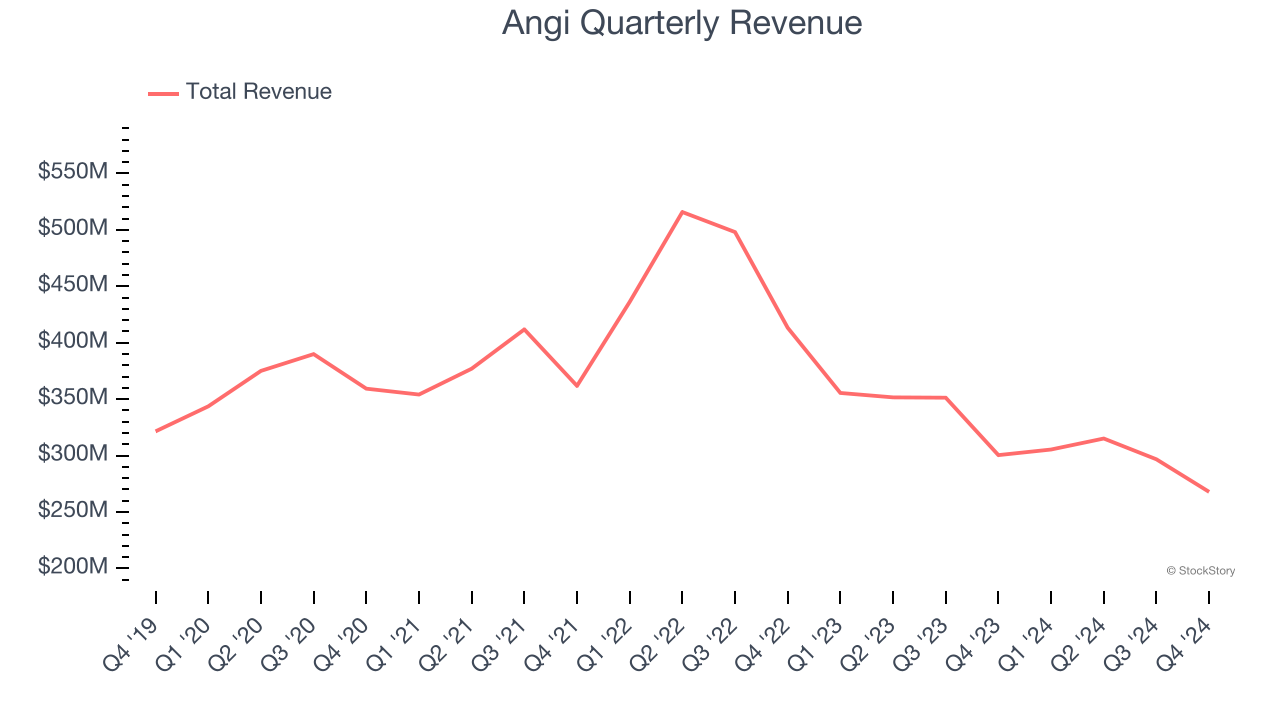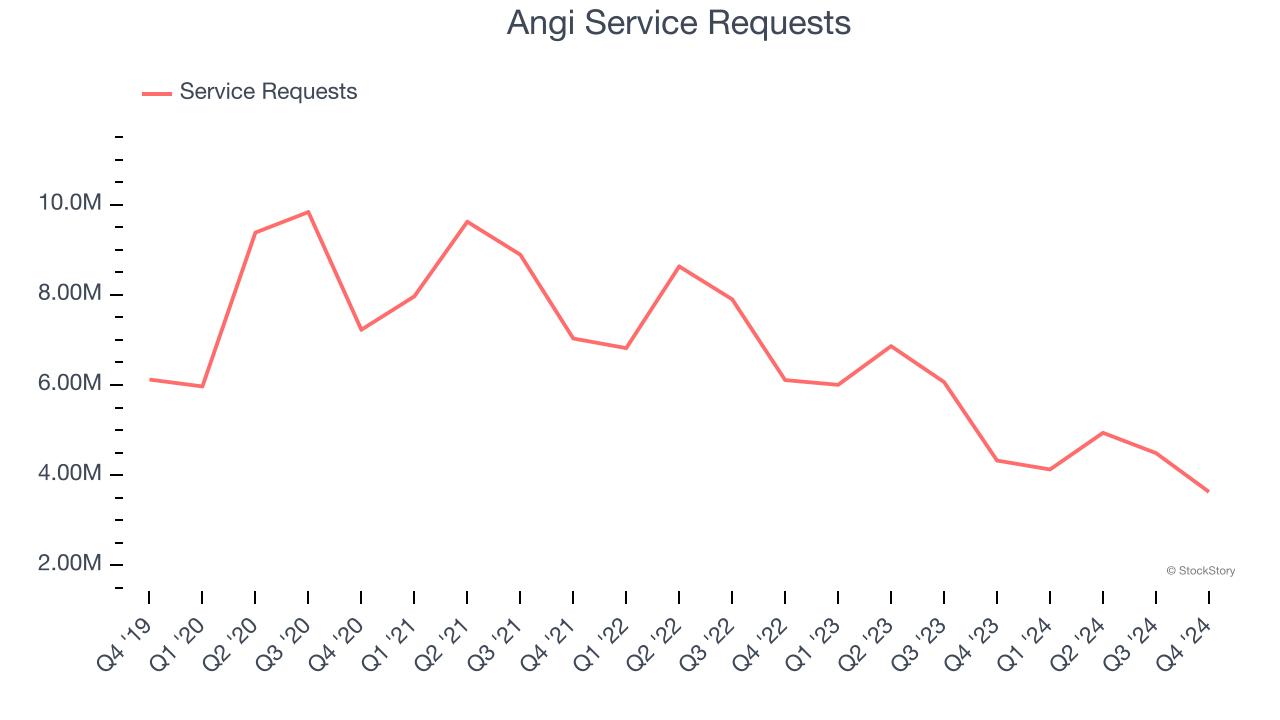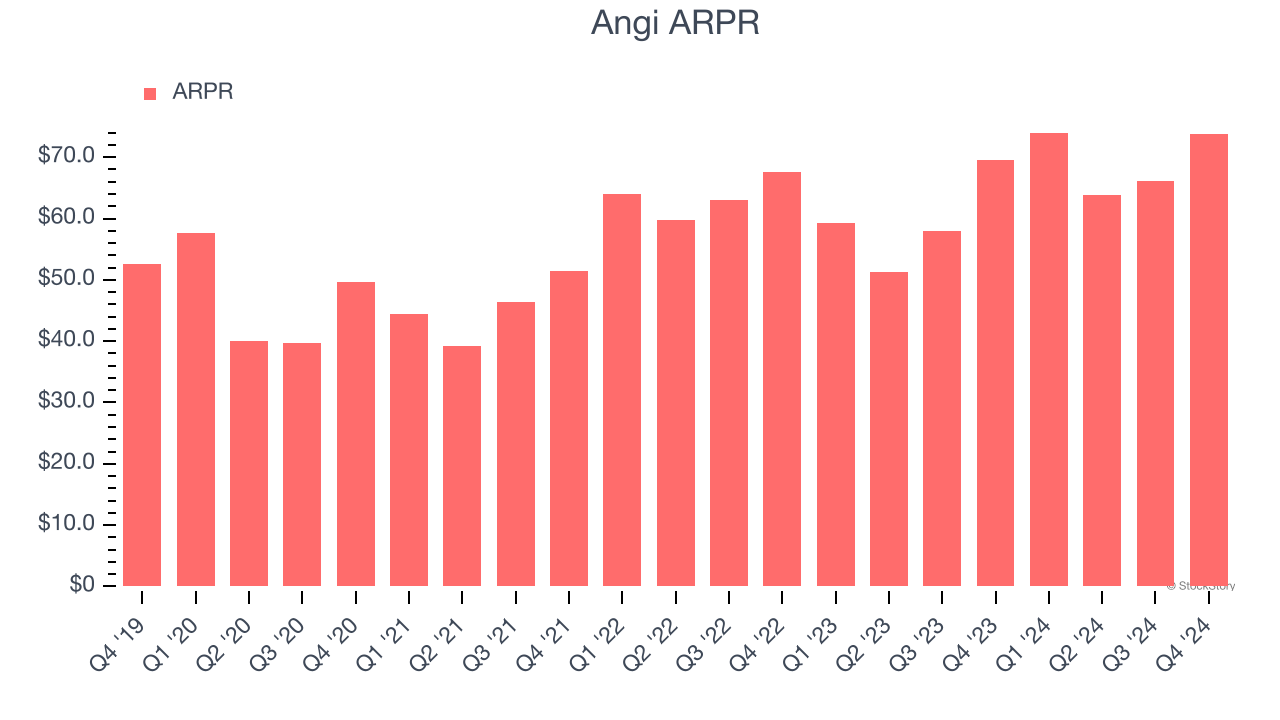
Home services online marketplace ANGI (NASDAQ: ANGI) reported Q4 CY2024 results beating Wall Street’s revenue expectations, but sales fell by 10.8% year on year to $267.9 million. Its GAAP loss of $0 per share was in line with analysts’ consensus estimates.
Is now the time to buy Angi? Find out by accessing our full research report, it’s free.
Angi (ANGI) Q4 CY2024 Highlights:
- Revenue: $267.9 million vs analyst estimates of $254.5 million (10.8% year-on-year decline, 5.3% beat)
- EPS (GAAP): $0 vs analyst estimates of $0 (in line)
- Adjusted EBITDA: $31.8 million vs analyst estimates of $28.65 million (11.9% margin, 11% beat)
- EBITDA guidance for the upcoming financial year 2025 is $142.5 million at the midpoint, in line with analyst expectations
- Operating Margin: 0.8%, down from 2.5% in the same quarter last year
- Free Cash Flow Margin: 10.1%, up from 6.3% in the previous quarter
- Service Requests: 3.63 million, down 695,000 year on year
- Market Capitalization: $870.2 million
Company Overview
Created by IAC’s mergers of Angie’s List and HomeAdvisor, ANGI (NASDAQ: ANGI) operates the largest online marketplace for home services in the US.
Gig Economy
The iPhone changed the world, ushering in the era of the “always-on” internet and “on-demand” services - anything someone could want is just a few taps away. Likewise, the gig economy sprang up in a similar fashion, with a proliferation of tech-enabled freelance labor marketplaces, which work hand and hand with many on demand services. Individuals can now work on demand too. What began with tech-enabled platforms that aggregated riders and drivers has expanded over the past decade to include food delivery, groceries, and now even a plumber or graphic designer are all just a few taps away.
Sales Growth
A company’s long-term performance is an indicator of its overall quality. While any business can experience short-term success, top-performing ones enjoy sustained growth for years. Angi’s demand was weak over the last three years as its sales fell at a 7.7% annual rate. This fell short of our benchmarks and is a sign of lacking business quality.

This quarter, Angi’s revenue fell by 10.8% year on year to $267.9 million but beat Wall Street’s estimates by 5.3%.
Looking ahead, sell-side analysts expect revenue to decline by 8.5% over the next 12 months, similar to its three-year rate. This projection is underwhelming and indicates its newer products and services will not accelerate its top-line performance yet.
Unless you’ve been living under a rock, it should be obvious by now that generative AI is going to have a huge impact on how large corporations do business. While Nvidia and AMD are trading close to all-time highs, we prefer a lesser-known (but still profitable) stock benefiting from the rise of AI. Click here to access our free report one of our favorites growth stories.
Service Requests
Request Growth
As a gig economy marketplace, Angi generates revenue growth by expanding the number of services on its platform (e.g. rides, deliveries, freelance jobs) and raising the commission fee from each service provided.
Angi struggled to engage its audience over the last two years as its service requests have declined by 23.3% annually to 3.63 million in the latest quarter. This performance isn't ideal because internet usage is secular, meaning there are typically unaddressed market opportunities. If Angi wants to accelerate growth, it likely needs to enhance the appeal of its current offerings or innovate with new products. 
In Q4, Angi’s service requests once again decreased by 695,000, a 16.1% drop since last year. On the bright side, the quarterly print was higher than its two-year result and suggests its new initiatives are accelerating request growth.
Revenue Per Request
Average revenue per request (ARPR) is a critical metric to track for gig economy businesses like Angi because it measures how much the company earns in transaction fees from each request. This number also informs us about Angi’s take rate, which represents its pricing leverage over the ecosystem, or "cut" from each transaction.
Angi’s ARPR growth has been decent over the last two years, averaging 5.3%. Although its service requests shrank during this time, the company’s ability to increase monetization demonstrates its platform’s value for existing requests. 
This quarter, Angi’s ARPR clocked in at $73.81. It grew by 6.2% year on year, faster than its service requests.
Key Takeaways from Angi’s Q4 Results
We were impressed by how significantly Angi blew past analysts’ EBITDA expectations this quarter. We were also excited its number of service requests outperformed Wall Street’s estimates, enabling it to beat on revenue. Zooming out, we think this quarter featured some important positives. The stock traded up 7.6% to $1.85 immediately after reporting.
Sure, Angi had a solid quarter, but if we look at the bigger picture, is this stock a buy? If you’re making that decision, you should consider the bigger picture of valuation, business qualities, as well as the latest earnings. We cover that in our actionable full research report which you can read here, it’s free.
